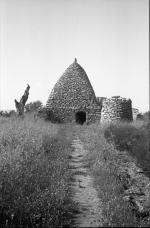|
Sem Babyjoy |
Manufactured or assembled in France from (Circa) 1960 to (Circa) 1965.
Index of rarity in France: Infrequent (among non-specialized garage sales)
Inventory number: 1029
See the complete technical specifications
Chronology of cameras Sem
After years of war and sometimes disorganized production, the immediate post-war years were marked by economic difficulties and reconstruction. The late 1950s and the following decade saw the return of prosperity, with a young generation seeking entertainment and leisure, enjoying increased purchasing power.
Black or gray cameras were no longer desirable. Sem enlisted the help of Roger Tallon to give a youthful makeover to their Baby Sem. The study resulted in the production of three models built on the same foundation. When viewed from the rear, they exhibit some similarities to the previous model, although the dimensions are different. The front is entirely different. Made of molded metal, it partially conceals the film advance and rewind buttons. A cover hides the base of the lens. Notched in its upper part, it reveals the aperture settings. At the top of the front section, there is a double attachment for connecting a flash. The viewfinder is off-center, whereas it was centered on the previous models. The back and the lower part of the front face are covered in vinyl coatings of various colors.
The three models are, in order of the range, the Babyjoy, the Babysem, and the Babylord. R. Tallon's office also worked on the typography of the names, with the capital "B" in the model names becoming lowercase.
Babyjoy (c. 1960 - c. 1965): A basic model with a single-speed Orec shutter (1/50). Aperture adjustment is possible either through three values labeled 1, 2, or 3 or through four weather-related pictograms. Note the inconsistency between the number of marks on the two scales. However, aperture adjustment is continuous. The paint on this model is smooth.
Babysem (c. 1960 - c. 1965): A model with no slow shutter speeds and limited to 1/250. Aperture adjustment is done using a standard scale. The paint has a vermiculated texture.
Babylord (c. 1962 - c. 1965): A high-end model with a shutter featuring slow speeds and a maximum speed of 1/400.
There is a color inversion of the strip between the Babyjoy and the other two models. The Babyjoy is aimed at appealing to younger users.
All three models have the same Berthiot lens with an aperture of 2.8.
Photo-Hall distributed the Babysem under the names Photo-Hall IA and later Photo-Hall SB1. Some shutters are marked Orec, while others have no markings. Shutter speeds start at 1/10 or 1/15. The Babylord was sold by this distributor under the name LPH1 (to date, no known examples have been encountered).

Interesting links or bibliography :
Add a link or element of bibliography, a picture taken with this camera, a picture of box or an ads about this camera
Your photos taken with the same camera:
Cameras from Ebay France (Sem) (Uploaded each 3 hours)








